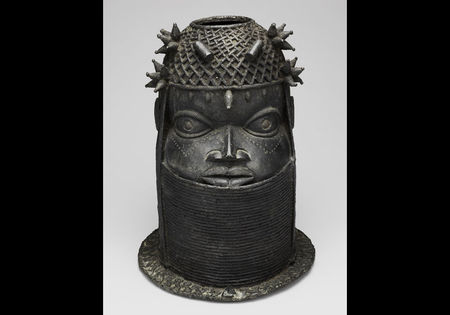"Benin—Kings and Rituals: Court Arts from Nigeria" @ the Art Institute of Chicagoago
Box in the Shape of an Antelope Head (Orievbee), 18th century. Nigeria, Benin Kingdom; Edo. Ivory; 16.5 x 29 x 11.5 cm (6 1/2 x 11 3/8 x 4 1/2 in.). Staatliche Museen zu Berlin, Ethnologisches Museum
CHICAGO.- Royal sculptures and regalia from the West African Kingdom of Benin are among the continent’s most historically important works of art. This summer, the Art Institute of Chicago will bring together more than 220 of these masterworks—from collections around the world—representing six centuries of Benin’s rich artistic heritage. Benin—Kings and Rituals: Court Arts from Nigeria, on view July 10 through September 21, is the most comprehensive and illuminating exhibition ever mounted about this West African kingdom and its distinctive artistic expressions. Organized by the Museum für Völkerkunde in Vienna in cooperation with the National Commission for Museums and Monuments in Nigeria, the Ethnologisches Museum in Berlin, the Art Institute, and the musée du quai Branly in Paris, this major exhibition has been seen in Vienna, Berlin, and Paris. It will conclude its tour in Chicago, with the Art Institute as its exclusive North American venue.
The Benin Kingdom came into existence in the 13th century and has no proper affiliation with the current Republic of Benin. This powerful, pre-colonial African state—located in present-day southwestern Nigeria—has been ruled by a dynasty of divine kings, called obas, for the past 700 years. Economic ties developed between the kingdom and Portugal as early as the 15th century, and fluid trade relations with Europe followed suit. The Kingdom’s earliest exports were pepper, enslaved captives, and ivory. From these earliest times, artists in Benin also crafted curios, including magnificent ivory salt cellars, spoons, and horns, for sale to European sailors and merchants. The depth of their artistry, however, which found its greatest expression in court art, was never fully revealed to outsiders. After a period of internal conflict in the 17th century, the empire and its economy were reenergized in the 18th century by an increased demand from Europe for ivory. In the 19th century, following the British prohibition of the slave trade, palm oil and textiles were the main exports. In 1897, after major conflicts with British forces over the control of trade, the city of Benin was conquered by Admiral Sir Harry Rawson and his troops, and the oba was exiled. Following these devastating events, hundreds of brass and ivory sculptures, along with royal regalia and other palace furnishings, were shipped to London, where they aroused considerable attention from the European public. Objects were subsequently sold to many museums where they reside to this day.
The lavishly articulated royal arts of Benin on view at the Art Institute affirm the centrality of the oba and portray his divine nature. Objects in the exhibition recount the kingdom’s significant historical events, activate the ruler’s interactions with the supernatural, and honor his deified ancestors. Such practices continue to this day and forge a connection with the past that is vital to the present-day kingdom’s viability. The wealth of iconographic detail in the art works conveys the sumptuousness of the royal court and its historical importance as a regional powerhouse in West Africa from the 16th through the 19th centuries.
Benin—Kings and Rituals: Court Arts from Nigeria marks the first time that masterpieces from the Benin Kingdom—dispersed in European and American collections since the late-19th century—are brought together and interpreted in light of modern scholarship.
Many examples of these superb sculptures will be on display: finely cast brass figures, altar heads, wall plaques, and staffs of office; sculpted ivories; royal regalia and jewelry in brass, coral, and ivory; and other accoutrements of life at court across six centuries. This important exhibition interweaves these objects within multifaceted themes to reconstruct and interpret the kingdom’s long, rich history. Planned with the most prominent scholars of Benin art, history, and culture, as well as the cooperation of reigning Oba Erediauwa and the National Commission for Museums and Monuments, Nigeria, Benin—Kings and Rituals seeks to bring international attention and new perspectives to Benin art and history.
Altar Head of an Oba (Uhunmwun Elao), 16th century. Nigeria, Benin Kingdom; Edo. Brass; 20 x 19 x 22 cm (7 7/8 x 7 1/2 x 8 5/8 in.). Staatliche Museen zu Berlin, Ethnologisches Museum

/https%3A%2F%2Fprofilepics.canalblog.com%2Fprofilepics%2F1%2F0%2F100183.jpg)
/https%3A%2F%2Fstorage.canalblog.com%2F03%2F02%2F119589%2F96711876_o.jpg)
/https%3A%2F%2Fstorage.canalblog.com%2F11%2F31%2F119589%2F94773502_o.jpg)
/https%3A%2F%2Fstorage.canalblog.com%2F20%2F83%2F119589%2F94772815_o.jpg)
/https%3A%2F%2Fstorage.canalblog.com%2F26%2F72%2F119589%2F75604929_o.jpg)
/https%3A%2F%2Fstorage.canalblog.com%2F59%2F60%2F119589%2F26458628_o.jpg)




/image%2F1371349%2F20240422%2Fob_9e242e_telechargement-8.jpg)
/image%2F1371349%2F20240422%2Fob_389183_telechargement-2.jpg)
/image%2F1371349%2F20240422%2Fob_49ce15_telechargement-4.jpg)
/image%2F1371349%2F20240422%2Fob_6346e5_438924379-1655367818566564-64033212096.jpg)